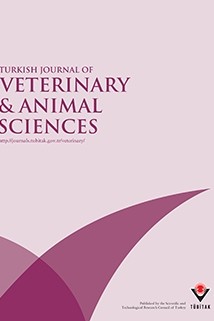
Turkish Journal of Veterinary and Animal Sciences
Yazarlar: Anatoliy NEZHDANOV, Sergey SHABUNIN, Vitaliy MIKHALEV, Nikolay KLIMOV, Anton CHERNITSKIY
Konular:-
DOI:10.3906/vet-1405-12
Anahtar Kelimeler:Fetal growth retardation syndrome,Cow,Ultrasound diagnostics,Hormones,Nitrogoxides,L-ascorbic acid
Özet: This research was conducted to study hormonal and metabolic statuses and to determine ultrasound criteria for early diagnosis of fetal growth retardation syndrome (FGRS) in dairy cows of Black-motley (n = 41) and Red-motley (n = 56) Holstein breeds. Concentrations of progesterone, testosterone, 17beta-estradiol, dehydroepiandrosterone sulfate, cortisol, and triiodothyronine in blood serum were assessed by immune-enzyme analysis. Concentrations of plasma L-ascorbic acid and nitrogen oxides, serum immune globulin, middle molecular peptides, and bactericidal and lysozyme activity were determined by spectrophotometry. On days 38-40 and 60-65 of gestation, FGRS in cows was associated with hypoprogesteronemia, decrease of adrenal and thyroid gland functions, decreased nitric oxide synthesis, low immune responsiveness, and high endogenous intoxication. In conclusion, body length less than 16 mm on days 38-40 and less than 45 mm on days 60-65 are the criteria for designating underdevelopment of embryos and fetuses in dairy cows. FGRS genesis in dairy cows is determined by the embryo's and fetus's malnutrition at the early implantation and placentation stages, caused by the imbalance of endocrine regulation, nitric oxide systems, and endogenous intoxication.
Dergi editörleri editör girişini kullanarak sisteme giriş yapabilirler. Editör girişi için tıklayınız.